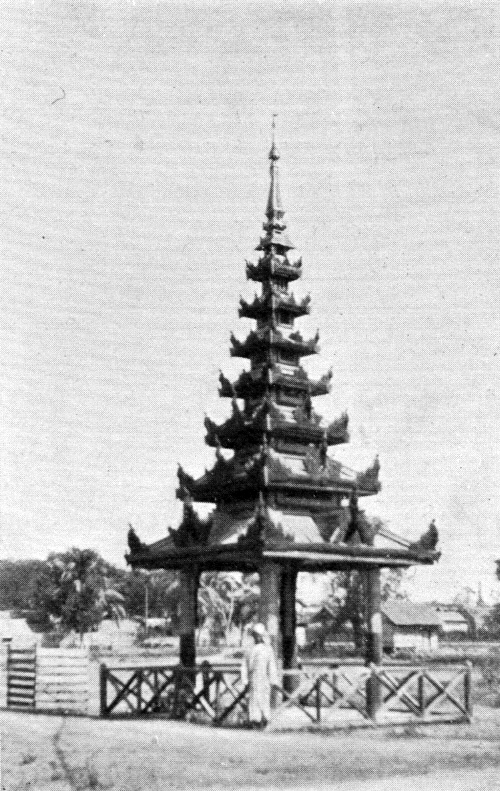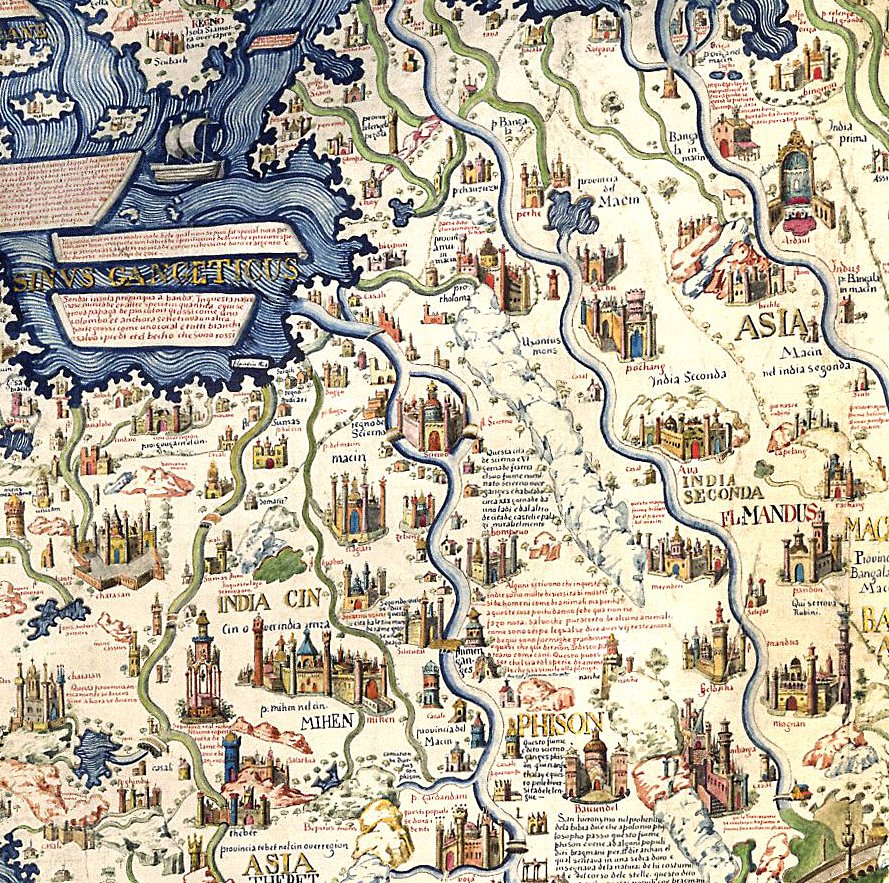|
Minkhaung Nawrahta
Minkhaung Nawrahta ( my, မင်းခေါင် နော်ရထာ ; c. 1714 – 5 December 1760) was a general of the Royal Burmese Army of the Konbaung Dynasty during the reign of King Alaungpaya. He is best known for his rearguard defense in the Burmese-Siamese War (1759–1760) in Siam as the Burmese forces rushed back a dying Alaungpaya back home. The general, who was well respected by the troops, then rebelled against Alaungpaya's successor Naungdawgyi. He believed he would be executed by the new king with whom he had a long history of enmity. The rebel general seized Ava in June 1760, and withstood the siege for over five months. He was killed by a musket shot as he fled the city in December. A remorseful Naungdawgyi was said to have mourned at the news of the death of his adversary and his father's brother in arms. Early life The future general was born Maung Ton ( ) in a small Upper Burma village of Moksobo (present-day Shwebo). He was a childhood friend of Aun ... [...More Info...] [...Related Items...] OR: [Wikipedia] [Google] [Baidu] |
Shwebo
Shwebo ( my, ရွှေဘိုမြို့ ) is a city in Sagaing Region, Burma, 110 km north-west of Mandalay between the Irrawaddy and the Mu rivers. The city was the origin of the Konbaung Dynasty, established by King Alaungpaya in 1752, that was the dominant political force in Burma after the mid-18th century. It served as Alaungpaya's capital from 1752 to 1760. As of 2021, it has a population of 88,914. History Up to 1752, Shwebo was a village, called Moksobo ( my, မုဆိုးဘို ; ) of about 300 houses. It lies near the site of the ancient Pyu city-state of Hanlin. On 29 February 1752, the chief of the village Aung Zeya founded the Konbaung Dynasty to resist the upcoming invasion of Lower Burma-based Hanthawaddy forces. Aung Zeya, who also assumed the royal title of Alaungpaya, gained the allegiance of 46 surrounding villages, and organized defenses building a stockade and digging a moat around Moksobo. He renamed his village, Shwebo (). Over the ... [...More Info...] [...Related Items...] OR: [Wikipedia] [Google] [Baidu] |
Burmese Honorifics
Burmese names lack the serial structure of most Western names. The Burmans have no customary matronymic or patronymic system and thus there is no surname at all. In the culture of Myanmar, people can change their name at will, often with no government oversight, to reflect a change in the course of their lives. Also, many Burmese names use an honorific, given at some point in life, as an integral part of the name. Traditional and Western-style names Burmese names were originally one syllable, as in the cases of U Nu and U Thant ("U" being an honorific). In the mid-20th century, many Burmese started using two syllables, albeit without any formal structure. In the late 1890s, British scholars observed that Rakhines commonly adopted three-syllable names whereas Burmans were still using one or two at most. As they become more familiar with Western culture, Burmese people are gradually increasing the number of syllables in their children's names, by use of various structures. Today ... [...More Info...] [...Related Items...] OR: [Wikipedia] [Google] [Baidu] |
Burmese Generals
Burmese may refer to: * Something of, from, or related to Myanmar, a country in Southeast Asia * Burmese people * Burmese language * Burmese alphabet * Burmese cuisine * Burmese culture Animals * Burmese cat * Burmese chicken * Burmese (horse), a horse given to Queen Elizabeth II * Burmese pony, a breed of horse * Burmese python See also * * :Burmese people * Bamar people, the majority ethnic group in Myanmar * Burmese English, the dialect of English spoken in Myanmar/Burma * Bernese (other) Bernese is the adjectival form for the canton of Bern or for Bern. Bernese may also refer to: * Bernese German, a Swiss German dialect of Alemannic origin generally spoken in the canton of Bern and its capital, and in some neighbouring regions * ... {{disambig Language and nationality disambiguation pages ... [...More Info...] [...Related Items...] OR: [Wikipedia] [Google] [Baidu] |
Konbaung Dynasty
The Konbaung dynasty ( my, ကုန်းဘောင်ခေတ်, ), also known as Third Burmese Empire (တတိယမြန်မာနိုင်ငံတော်) and formerly known as the Alompra dynasty (အလောင်းဘုရားမင်းဆက်, Alaungphra dynasty) and the Hunter dynasty (မုဆိုးမင်းဆက် Mokso dynasty / မုဆိုးဘိုမင်းဆက် Moksobo dynasty), was the last dynasty that ruled Burma/Myanmar from 1752 to 1885. It created the second-largest empire in Burmese history and continued the administrative reforms begun by the Toungoo dynasty, laying the foundations of the modern state of Burma. The reforms, however, proved insufficient to stem the advance of the British, who defeated the Burmese in all three Anglo-Burmese Wars over a six-decade span (1824–1885) and ended the millennium-old Burmese monarchy in 1885. An expansionist dynasty, the Konbaung kings waged campaigns against Mani ... [...More Info...] [...Related Items...] OR: [Wikipedia] [Google] [Baidu] |
Hsinbyushin
Hsinbyushin ( my, ဆင်ဖြူရှင်, , ; th, พระเจ้ามังระ; 12 September 1736 – 10 June 1776) was king of the Konbaung dynasty of Burma (Myanmar) from 1763 to 1776. The second son of the dynasty founder Alaungpaya is best known for his wars with China and Siam, and is considered the most militaristic king of the dynasty. His successful defense against four Chinese invasions preserved Burmese independence. His invasion of Siam (1765–1767) ended Siam's Ayutthaya Dynasty. The near simultaneous victories over China and Siam has been referred to as testimony "to a truly astonishing elan unmatched since Bayinnaung." He also raised the Shwedagon Pagoda to its current height in April 1775. The deputy commander-in-chief during his father's reunification campaigns (1752–1759), Hsinbyushin as king pursued an expansionist policy against his neighbors. By 1767, his armies had put down a rebellion in Manipur, captured the Laotian states, tempora ... [...More Info...] [...Related Items...] OR: [Wikipedia] [Google] [Baidu] |
Ayutthaya (city)
Phra Nakhon Si Ayutthaya ( th, พระนครศรีอยุธยา, ; also spelled "Ayudhya"), or locally and simply Ayutthaya, is the former capital of Phra Nakhon Si Ayutthaya province in Thailand. Located on an island at the confluence of the Chao Phraya and Pa Sak rivers, Ayutthaya is the birthplace of the founder of Bangkok, King Rama I. Etymology Ayutthaya is named after the city of Ayodhya in India, the birthplace of Rama in the ''Ramayana'' ( Thai, ''Ramakien''); (from Khmer: ''preah'' ព្រះ ) is a prefix for a noun concerning a royal person; designates an important or capital city (from Sanskrit: ''nagara''); the Thai honorific ''sri'' or ''si'' is from the Indian term of veneration Shri. History Prior to Ayutthaya's traditional founding date, archaeological and written evidence has revealed that Ayutthaya may have existed as early as the late 13th century as a water-borne port town. Further evidence of this can be seen with Wat Phanan Choen ... [...More Info...] [...Related Items...] OR: [Wikipedia] [Google] [Baidu] |
Toungoo Dynasty
, conventional_long_name = Toungoo dynasty , common_name = Taungoo dynasty , era = , status = Empire , event_start = Independence from Ava , year_start = 1510 , date_start = 16 October , event_end = End of dynasty , year_end = 1752 , date_end = 23 March , event_pre = , date_pre = 1485 , event1 = , date_event1 = 1510–99 , event2 = , date_event2 = 1599–1752 , event3 = , date_event3 = , event4 = , date_event4 = , p1 = Ava Kingdom , p2 = Hanthawaddy Kingdom , p3 = Shan states , p4 = Lan Na Kingdom , p5 = Ayutthaya Kingdom , p6 = Lan Xang Kingdom , p7 ... [...More Info...] [...Related Items...] OR: [Wikipedia] [Google] [Baidu] |
Restored Hanthawaddy Kingdom
The Restored Hanthawaddy Kingdom ( my, ဟံသာဝတီ နေပြည်တော်သစ်), also known as the Neo-Ramanic State () was the kingdom that ruled Lower Burma and parts of Upper Burma from 1740 to 1757. The kingdom grew out of a rebellion by the Mon led population of Pegu, who then rallied the other Mon as well as Delta Bama and Karens of Lower Burma, against the Toungoo Dynasty of Ava in Upper Burma. The rebellion succeeded in expelling Toungoo loyalists and restored the Mon-speaking Kingdom of Hanthawaddy ruled Lower Burma from 1287 to 1539. The restored Hanthawady kingdom also claim heritage to Bayinaung's early Toungoo Empire whose capital was based in Pegu and guaranteed the loyalty of the non-Mon population of Lower Burma. Supported by the French, the upstart kingdom quickly carved out a space for itself in Lower Burma, and continued its push northward. In March 1752, its forces captured Ava, and ended the 266-year-old Toungoo dynasty. A new dynas ... [...More Info...] [...Related Items...] OR: [Wikipedia] [Google] [Baidu] |
Inwa
Inwa (, or ; also spelled Innwa; formerly known as Ava), located in Mandalay Region, Myanmar, is an ancient imperial capital of successive Burmese kingdoms from the 14th to 19th centuries. Throughout history, it was sacked and rebuilt numerous times. The capital city was finally abandoned after it was destroyed by a series of major earthquakes in March 1839. Though only a few traces of its former grandeur remain today, the former capital is a popular day-trip tourist destination from Mandalay. Etymology The name Inwa (အင်းဝ) literally means "mouth of the Lake", reflecting its geographical location at the mouth of lakes in the Kyaukse District. Another theory states that it is derived from ''Innawa'' (), meaning "nine lakes" in the area.Khin Khin Aye 2007: 60 The city's classical name in Pali is ''Ratanapura'' (ရတနပုရ; "City of Gems"). The modern standard Burmese pronunciation is ''Inwa'' (), following the modern orthography. But the local Upper Burmes ... [...More Info...] [...Related Items...] OR: [Wikipedia] [Google] [Baidu] |
Kyaukse
Kyaukse ( my, ကျောက်ဆည် မြို့, ) is town and capital of Kyaukse District in Mandalay Region, Myanmar. Lying on the Zawgyi River, 25 miles (40 km) south of Mandalay, it is served by the Mandalay-Yangon (Rangoon) railway. The first Myanmar probably settled in the area about 800, and local 12th- and 13th-century inscriptions refer to Kyaukse as “the first home”. Remains of pagodas and old cities are found throughout the area. The Shwethalyaung Pagoda, built by King Anawrahta (1044–77), is located in Kyaukse. Kyaukse is famous for the Kyaukse elephant dance festival, and for being the home town of former dictator Senior General Than Shwe. The town's industrial zone is one of more than 30 across the country. Geography The surrounding area consists of a level strip running south from Mandalay along the foothills of the Shan Plateau. The area is located in the heart of Myanmar’s dry zone but is drained by the Panlaung and Zawgyi rivers, which were ... [...More Info...] [...Related Items...] OR: [Wikipedia] [Google] [Baidu] |
Naungdawgyi
Dabayin Min ( my, ဒီပဲယင်းမင်း), commonly known as Naungdawgyi ( my, နောင်တော်ကြီး ; 10 August 1734 – 28 November 1763) was the second king of Konbaung Dynasty of Burma (Myanmar), from 1760 to 1763. He was a top military commander in his father Alaungpaya's reunification campaigns of the country. As king, he spent much of his short reign suppressing multiple rebellions across the newly founded kingdom from Ava (Inwa) and Toungoo (Taungoo) to Martaban (Mottama) and Chiang Mai. The king suddenly died less than a year after he had successfully suppressed the rebellions. He was succeeded by his younger brother Hsinbyushin. Early life Naungdawgyi was born Maung Lauk () to Yun San and Aung Zeya (later King Alaungpaya) on 10 August 1736 (Tuesday, 11th waxing of Wagaung 1096 ME) in a small village of Moksobo, about 60 miles northwest of Ava (Inwa).Maung Maung Tin Vol. 1 1905: 263 He was the eldest child of the couple's nine children. ... [...More Info...] [...Related Items...] OR: [Wikipedia] [Google] [Baidu] |



